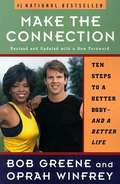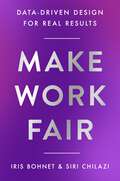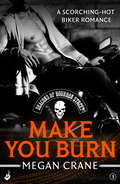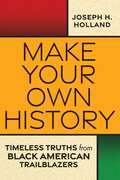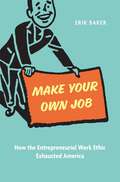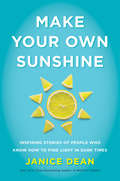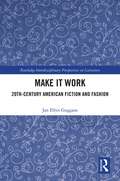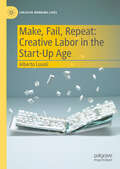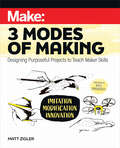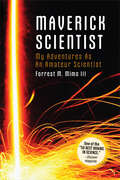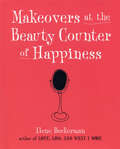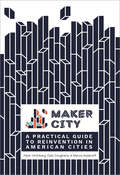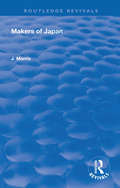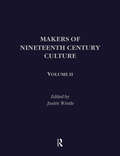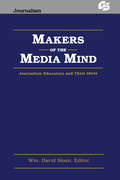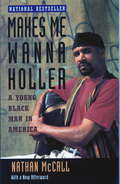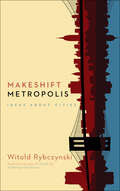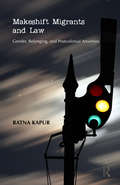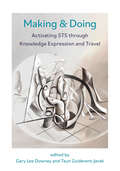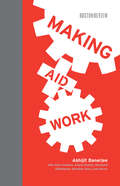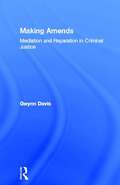- Table View
- List View
Make The Connection: Ten Steps To A Better Body And A Better Life
by Bob Greene Oprah Winfrey Julie JohnsonAfter trying every diet program imaginable--from Atkins to Optifast--media giant and self-confessed junk-food junkie Oprah Winfrey met personal trainer and exercise physiologist Bob Greene. The rest is talk-show history. (Who can forget seeing Oprah wheeling that wagon of fat onstage? ) Instead of fad diets, fasts, and quick fixes, Greene taught Oprah how to eat right and exercise regularly. He helped her lose more than 70 pounds and changed her life forever. In Make the Connection, Greene tells you how to lose weight the Oprah way: with hard work that includes a sensible diet and daily workouts. He gives 10 steps that he believes are the fastest and most effective ways to increase your metabolism and decrease your weight. You'll also learn why we eat, how to become self-aware, the purpose of body fat, and the physics of body weight. To keep you motivated, Oprah shares her personal shape-up story and offers suggestions for sticking with the program. Make the Connection is about more than shedding pounds. It is also about making a daily commitment to take care of your body and feel better about yourself.
Make Work Fair: Data-Driven Design for Real Results
by Iris Bohnet Siri ChilaziTwo leading gender experts and Harvard researchers reveal a new paradigm for fairness at work and offer professionals at every level, in any kind of organization, immediate, proven, and evidence-based ways to do their everyday work better and smarter—and more fairly.To make organizations more fair, many well-meaning individuals and companies invest their time and resources in diversity, equity, and inclusion (DEI) initiatives. But because inequity is built into the structures, processes, and environments of our workplaces, adding these programs has been ineffective and often becomes a burden passed off to the individuals they are meant to help.In Make Work Fair, behavioral scientist and author of What Works Iris Bohnet and gender expert Siri Chilazi offer data-backed, actionable solutions that build fairness into the very fabric of the workplace. Their methods—tested at many organizations, and grounded in data proven to work in the real world—help us make fairer, and simply better, decisions. Using their three-part framework, employees at all levels can embed fairness into their everyday practices.Believing in equal opportunity is essential—but it isn’t enough. Offering an evidence-based blueprint, Make Work Fair shows you how to make it a reality, no matter your role, seniority, responsibilities, or where you are in the world.
Make You Burn: Deacons of Bourbon Street 1 (Deacons of Bourbon Street #4)
by Megan CraneMeet the Deacons of Bourbon Street, bad boy bikers who are hell on wheels and heaven between the sheets. Fans of Madeline Sheehan, Katie Ashley, Joanna Wylde and Kristen Ashley, buckle up - you're in for a wild ride. First stop: Make You Burn by Megan Crane.Sean 'Ajax' Harding's oaths are inked into his skin. Once second-in-command of the Deacons of Bourbon Street motorcycle club, he left New Orleans to protect his brotherhood. But the death of his beloved mentor, Priest Lombard, has lured him back. Heading straight to the club's hangout, he's welcomed by the delectable new owner. A wild ride with her is just what he needs - until he finds out she's Priest's daughter, all grown up and off limits.Sophie Lombard loved her father, but she's done with bikers. Then Ajax roars into town and changes everything. Sophie knows better than to get close to an outlaw but Ajax is impossible to resist. Their chemistry is steamier than the Louisiana bayou - and with heat like this, it might just be worth getting burned.For more badass bikers, don't miss the rest of the Deacons of Bourbon Street series: Fire Me Up by Rachael Johns, Hold Me Down by Jackie Ashenden, and Strip You Bare by Maisey Yates.
Make Your Own History: Timeless Truths from Black American Trailblazers
by Joseph H. HollandCelebrating the vast breadth and scope of Black excellence, Make Your Own History shares success principles exemplified by 120 Black unsung heroes who have blazed trails throughout American history. One hundred and twenty Black leaders, innovators, and entrepreneurs share their wisdom and experience across the centuries in Make Your Own History, an inspiring collection of exemplary Black voices—past and present, familiar and unsung—which have the power to guide us today. Make Your Own History gathers together motivational quotes, historical contexts, and enlightening precepts from Black trailblazers spanning the eighteenth century to the present. These insights encompass twelve central themes: courage, self-discipline, compassion, perseverance, teamwork, integrity, industriousness, self-reliance, optimism, purposefulness, civility, and faith. These vigorous virtues will: *Deepen your courage through journalist Ida B. Wells&’ strategic activism in the face of professional and personal peril . . . *Fuel your perseverance through tennis superstar Serena Williams&’ journey to 23 Grand Slam singles titles . . . *Spark optimism through poet Langston Hughes&’ work as an artistic and intellectual catalyst for the Harlem Renaissance . . . Through these perspectives and so many more, Make Your Own History serves not only as an uplifting historical resource, but also as a spiritual road map for the life-long journey of purposefully setting and meeting personal goals. These pioneers are more than historic examples of Black excellence; their unique lives highlight universal truths that will inspire all readers to achieve great success and make their own history.
Make Your Own Job: How the Entrepreneurial Work Ethic Exhausted America
by Erik BakerA sweeping new history of the changing meaning of work in the United States, from Horatio Alger to Instagram influencers.How Americans think about work changed profoundly over the course of the twentieth century. Thrift and persistence came to seem old-fashioned. Successful workers were increasingly expected to show initiative and enthusiasm for change—not just to do their jobs reliably but to create new opportunities for themselves and for others. Our culture of work today is more demanding than ever, even though workers haven't seen commensurate rewards.Make Your Own Job explains how this entrepreneurial work ethic took hold, from its origins in late nineteenth-century success literature to the gig economy of today, sweeping in strange bedfellows: Marcus Garvey and Henry Ford, Avon ladies and New Age hippies. Business schools and consultants exhorted managers to cultivate the entrepreneurial spirit in their subordinates, while an industry of self-help authors synthesized new ideas from psychology into a vision of work as “self-realization.” Policy experts embraced the new ethic as a remedy for urban and Third World poverty. Every social group and political tendency, it seems, has had its own exemplary entrepreneurs.Historian Erik Baker argues that the entrepreneurial work ethic has given meaning to work in a world where employment is ever more precarious––and in doing so, has helped legitimize a society of mounting economic insecurity and inequality. From the advent of corporate capitalism in the Gilded Age to the economic stagnation of recent decades, Americans have become accustomed to the reality that today’s job may be gone tomorrow. Where work is hard to find and older nostrums about diligent effort fall flat, the advice to “make your own job” keeps hope alive.
Make Your Own Sunshine: Inspiring Stories of People Who Find Light in Dark Times
by Janice DeanThese are the kinds of stories we need right now.While the news is filled with villains and villainy, we do see a few famous heroes now and again. But what about the everyday heroes? The people going out of their way bring a little love into someone else's life? They deserve a time in the spotlight to inspire us all.Life can be tough—but it helps to know other people have come through hard times with a smile on their face. In Make Your Own Sunshine, Janice Dean shares inspiring stories that will lift your spirit and touch your heart. Good people are all around us doing selfless deeds, from a firefighter who bravely battled for his colleague’s health after 9/11 to a good Samaritan who secretly pays for the coffees of everyone in line behind him. You can’t help but smile reading about the teacher who cut her hair to make her student feel better. And you may shed a tear when you hear the story of the dad who never missed writing a napkin note for his daughter, including stashing extra notes in case he lost his batter with cancer. From a young man who makes bow ties for dogs waiting to be adopted to an Uber driver who brightened a new mom’s day by helping her buy baby clothes, the heroes in this story will warm your heart and stick in your mind.Janice has made it her mission to uncover and document these good stories to inspire us and gives us a much-needed boost of optimism. All we have to do is open our minds and our hearts, to look for the light on a cloudy day. Because as she reminds us, if we don’t make our own sunshine—who will?
Make it Work: 20th Century American Fiction and Fashion (Routledge Interdisciplinary Perspectives on Literature)
by Jan Ellyn GoggansImagine a new critical theory that bases its literary value on fashion. In this theory exists a community that explores and interrogates conventionality, and in American literature of the 20th century, it includes fashion and home decoration, two paths to achieving white femininity, a prized component of many novels written by and for women. Drawing on cultural materialism and its connection to the cultural forms of objects, including apparel, Making it Work: 20th Century American Fiction and Fashion provides readers a new understanding of the aims of American writers, and the desires of their readers.
Make the Night Hideous
by Pauline GreenhillThe charivari is a loud, late-night surprise house-visiting custom from members of a community, usually to a newlywed couple, accompanied by a quête (a request for a treat or money in exchange for the noisy performance) and/or pranks. Up to the first decades of the twentieth century, charivaris were for the most part enacted to express disapproval of the relationship that was their focus, such as those between individuals of different ages, races, or religions. While later charivaris maintained the same rituals, their meaning changed to a welcoming of the marriage.Make the Night Hideous explores this mysterious transformation using four detailed case studies from different time periods and locations across English Canada, as well as first-person accounts of more recent charivari participants. Pauline Greenhill's unique and fascinating work explores the malleability of a tradition, its continuing value, and its contestation in a variety of discourses.
Make, Fail, Repeat: Creative Labor in the Start-Up Age (Creative Working Lives)
by Alberto LusoliThis book examines how the concept of 'Start-up' has transcended its original acceptation as a synonym for an early-stage, hi-tech company, to become a historically specific way of knowing and acting in the world. 'Start-up' is everywhere. The term has been employed since the 1970s to indicate any company with a limited operating history and in a phase of market discovery. In the 1990s, the term gained a more preciseconnotation, one connected to the kind of experimental, technology-based, and venture-backed businessesthat became the most visible embodiment of the New Economy techno-utopianism. Today, the term is widely known and used beyond managerial circles, so much so that it has become a subject of TV showssuch as Shark Tank, MTV&’s Dropout, and HBO&’s irreverent series Silicon Valley. 'Start-up' is no longer just an economic and managerial concept but, the book argues, also a cultural phenomenon that is reshaping the way we conceive work in the 21st century. It does this by furthering the idea that withdrawal from traditional disciplinary regimes such as formal education and wage labor is a necessary step on the pathtoward professional realization and personal freedom. But what happens when one decides to leave the safe harbor of regular employment and set sail on the tumultuous waters of independent work? The book addresses this question through a 22-month ethnographic investigation of the Vancouver new media and digital industries. Through interviews with creative practitioners and participation in informal gatheringsfor tech workers, the book provides a compelling perspective on creative work in the start-up age.
Make: Designing Purposeful Projects to Teach Maker Skills
by Matt ZiglerThe Maker movement has been an excellent opportunity for people to become producers rather than just consumers, and schools are recognizing the value of offering students the tools, materials, and skills necessary to design sophisticated and meaningful projects. But teaching technical skills should not be the end goal: At its best, a Maker education teaches students to think and act in creative ways that can be applied to difficult challenges in all areas of life.Three Modes of Making provides a framework for Maker courses in upper grades that teach students creative-process skills through three key Maker modes: Imitation, Modification, and Innovation. Educators will learn the differences between the three Maker modes, their associated skill sets, and gain concrete methods to teach, document, and assess these skills. Through this approach, teachers will enable students to apply them to different creative needs.By focusing on how to teach skill development rather than merely how to build specific objects, Three Modes of Making enables students to improve and enhance their creative skills, and learn ways to apply them to a wide variety of challenges. This book is a road map to developing the creative problem solvers that the world needs for the future.
Make: My Adventures as an Amateur Scientist
by Forrest M. MimsMaverick Scientist is the memoir of Forrest Mims, who forged a distinguished scientific career despite having no academic training in science. Named one of the "50 Best Brains in Science" by Discover magazine, Forrest shares what sparked his childhood curiosity and relates a lifetime of improbable, dramatic, and occasionally outright dangerous experiences in the world of science.At thirteen he invented a new method of rocket control. At seventeen he designed and built an analog computer that could translate Russian into English and that the Smithsonian collected as an example of an early hobby computer. While majoring in government at Texas A&M University, Forrest created a hand-held, radar-like device to help guide the blind. And during his military service, he had to be given special clearance to do top secret laser research at the Air Force Weapons Lab. Why? Because while he lacked the required engineering degree, they wanted his outside-the-box thinking on the project.He went on to co-found MITS, Inc., producer of the first commercially successful personal computer, wrote a series of electronics books for Radio Shack that sold more than seven million copies, and designed the music synthesizer circuit that became known as the infamous Atari Punk Console. All this came before he started consulting for NASA's Goddard Space Flight Center, and NOAA's famous Mauna Loa Observatory, and earning the prestigious Rolex Award.This intimate portrait of a self-made scientist shares a revelatory look inside the scientific community, and tells the story of a lifelong learner who stood by his convictions even when pressured by the establishment to get in line with conventional wisdom. With dozens of personal photos and illustrations, Maverick Scientist serves as proof that to be a scientist, you simply need to do science.
Makeovers at the Beauty Counter of Happiness
by Ilene Beckerman"During my life, I've spent thousands of hours and thousands of dollars on my hair, my makeup, and my clothes, trying to look prettier because I grew up believing that pretty girls had happier lives." "I'd be a lot happier now if I had that time and that money back." Ilene Beckerman has lived long enough to have finally learned that there's more to happiness than finding the right hairdo and maintaining an ideal weight. This is never more clear than when she's invited to her fiftieth elementary-school reunion. "Of course I'd go to the reunion." Beckerman says. But delight soon turns to dismay: "I wondered who'd be there. How would they look? Would I look as good? What would I wear? Could I lose twenty pounds by June?" Her reunion presents the perfect occasion to illustrate the anxieties and doubts, the dreams and hard-earned triumphs, of women—from Queen Victoria to Britney Spears. Beckerman knows what really matters in life (besides good hair), and she imparts her wisdom in letters (unsent) to Madonna, Ava Gardner, Sofia Coppola, Meryl Streep, Gwyneth Paltrow, and others, and to her granddaughter Olivia. Frida Kahlo, Cinderella, Whistler's Mother, and Audrey Hepburn make appearances too. In this wise and wonderful book, she shares a lifetime of experience that reminds us that, ultimately, our mothers (and our grandmothers) were right: real beauty comes from within.
Maker City: A Practical Guide for Reinventing American Cities
by Dale Dougherty Marcia Kadanoff Peter HirshbergThe Maker City Playbook is a comprehensive case studies and how-to information useful for city leaders, civic innovators, nonprofits, and others engaged in urban economic development. The Maker City Playbook is committed to going beyond stories to find patterns and discern promising practices to help city leaders make even more informed decisions.Maker City PlaybookChapter 1: Introduction and a Call to ActionChapter 2: The Maker movement and CitiesChapter 3: The Maker City as Open EcosystemChapter 4: Education and Learning in the Maker CityChapter 5: Workforce Development in the Maker CityChapter 6: Advanced Manufacturing and Supply Chain inside the Maker CityChapter 7: Real Estate Matters in the Maker CityChapter 8: Civic Engagement in the Maker CityChapter 9: The Future of the Maker CityMaker City Project is a collaboration between the Kauffman Foundation, the Gray Area for the Arts, and Maker Media.
Makers Of Japan (Routledge Revivals)
by J MorrisFirst Published in 1906, Morris melds Japanese culture and historic past to create a discourse on the change in attitude to foreign powers in the 1800’s. By providing a general impression of Japan and her people, and discussing the workings of reform, as exemplified in the lives of her patriots, the book explores Japan’s status amongst the international community as an enlightened nation and modern powerhouse.
Makers of Nineteenth Century Culture
by Justin WintleThis volume provides a critical examination of the lives and works of the leading novelists, poets, dramatists, artists, philosophers, social thinkers, mathematicians and scientists of the period. The subjects are assessed in the light of their cultural importance, and each entry is deliberately interpretative, making this work both an essential reference tool and an engaging collection of essays. Figures covered include: Marx, Wagner,Darwin, Malthus, Balzac, Jane Austen, Nietzsche, Babbage, Edgar Allan Poe, Ruskin, Schleiermacher, Herbert Spencer, Harriet Martineau and Oscar Wilde.
Makers of the Media Mind: Journalism Educators and their Ideas (Routledge Communication Series)
by Wm. David SloanMakers of the Media Mind is a collection of analytical essays focusing on the most important and original ideas contributed to the field of mass communication by journalism educators. Divided into six sections representing the most prominent areas of specialization in the field, this text serves two significant purposes: first, it acquaints readers with the lives of preeminent journalism educators; second, it provides concise discussions and evaluations of the most compelling ideas those educators have to offer. The editor of, and contributors to, this text contend that ideas cannot be appreciated fully without an understanding of the creators of those same ideas. They hope that this volume's coverage of "creators" as well as concepts will demonstrate that journalism education has played a critical role in the making of the "media mind."
Makes Me Wanna Holler: A Young Black Man in America
by Nathan MccallExamining the complexities of the problems of black youths from an insider's perspective, an African-American journalist recalls his own troubled childhood, his rehabilitation while in prison, and his successful Washington Post career.
Makeshift Metropolis
by Witold RybczynskiIn this new work, prizewinning author, professor, and Slate architecture critic Witold Rybczynski returns to the territory he knows best: writing about the way people live, just as he did in the acclaimed bestsellers Home and A Clearing in the Distance. In Makeshift Metropolis, Rybczynski has drawn upon a lifetime of observing cities to craft a concise and insightful book that is at once an intellectual history and a masterful critique. Makeshift Metropolis describes how current ideas about urban planning evolved from the movements that defined the twentieth century, such as City Beautiful, the Garden City, and the seminal ideas of Frank Lloyd Wright and Jane Jacobs. If the twentieth century was the age of planning, we now find ourselves in the age of the market, Rybczynski argues, where entrepreneurial developers are shaping the twenty-first-century city with mixed-use developments, downtown living, heterogeneity, density, and liveliness. He introduces readers to projects like Brooklyn Bridge Park, the Yards in Washington, D.C., and, further afield, to the new city of Modi'in, Israel--sites that, in this age of resource scarcity, economic turmoil, and changing human demands, challenge our notion of the city. Erudite and immensely engaging, Makeshift Metropolis is an affirmation of Rybczynski's role as one of our most original thinkers on the way we live today.
Makeshift Metropolis: Ideas about Cities
by Witold RybczynskiIn this new work, prizewinning author, professor, and Slate architecture critic Witold Rybczynski returns to the territory he knows best: writing about the way people live, just as he did in the acclaimed bestsellers Home and A Clearing in the Distance. In Makeshift Metropolis, Rybczynski has drawn upon a lifetime of observing cities to craft a concise and insightful book that is at once an intellectual history and a masterful critique. Makeshift Metropolis describes how current ideas about urban planning evolved from the movements that defined the twentieth century, such as City Beautiful, the Garden City, and the seminal ideas of Frank Lloyd Wright and Jane Jacobs. If the twentieth century was the age of planning, we now find ourselves in the age of the market, Rybczynski argues, where entrepreneurial developers are shaping the twenty-first-century city with mixed-use developments, downtown living, heterogeneity, density, and liveliness. He introduces readers to projects like Brooklyn Bridge Park, the Yards in Washington, D.C., and, further afield, to the new city of Modi'in, Israel--sites that, in this age of resource scarcity, economic turmoil, and changing human demands, challenge our notion of the city. Erudite and immensely engaging, Makeshift Metropolis is an affirmation of Rybczynski's role as one of our most original thinkers on the way we live today.
Makeshift Migrants and Law: Gender, Belonging, and Postcolonial Anxieties
by Ratna KapurThis book unmasks the cultural and gender stereotypes that inform the legal regulation of the migrant. It critiques the postcolonial perspective on how belonging and non-belonging are determined by the sexual, cultural, and familial norms on which law is based as well as the historical backdrop of the colonial encounter, which differentiated overtly between the legitimate and illegitimate subject. The complexities and layering of the migrant’s existence are seen, in the book, to be obscured by the apparatus of the law. The author elaborates on how law can both advance and impede the rights of the migrant subject and how legal interventions are constructed around frameworks rooted in the boundaries of difference, protection of the sovereignty of the nation-state, and the myth of the all-embracing liberal subject. This produces the ‘Other’ and reinforces essentialised assumptions about gender and cultural difference. The author foregrounds the perspective of the subaltern migrant subject, exposing the deeper issues implicated in the debates over migration and the rights claims of migrants, primarily in the context of women and religious minorities in India.
Making & Doing: Activating STS through Knowledge Expression and Travel
by Gary Lee Downey and Teun Zuiderent-JerakHow ten making & doing projects expand STS scholarship through a focus on knowledge expression and knowledge travel in addition to knowledge production.Making & doing projects expand STS scholarship to include the trajectories of STS knowledge flow beyond the boundaries of the field by actively interweaving knowledge expression and travel with knowledge production. In this edited volume, contributors from around the world present and critically assess ten empirical making & doing projects. They recount how their projects advance STS, and describe how they themselves learn from their interlocutors and the settings in which they do and share their STS work. A coda explains how the infrastructures of STS scholarship are broadening to include practices of making & doing. The contributors examine and reflect upon their dilemmas, frustrations, and failures, especially when these generate new practices that might not have occurred had their work not taken the form of making and doing scholarship. While each project raises a distinct set of scholarly issues, all of the projects include practices that express STS knowledge through &“STS sensibilities&” and attach those sensibilities to practices in empirical fields. The ten projects include one each in Argentina, Taiwan, Canada, and Denmark; two in the US; one in Austria, the UK, and multiple countries in Africa and Asia; one in the US and Latin America; one in the Netherlands and Australia; and one in an international network that includes members from Europe, the Americas, and Australia.
Making Aboriginal Men and Music in Central Australia (Criminal Practice Ser.)
by Ase OttossonThis detailed ethnographic study explores the intercultural crafting of contemporary forms of Aboriginal manhood in the world of country, rock and reggae music making in Central Australia. Focusing on four different musical contexts – an Aboriginal recording studio, remote Aboriginal settlements, small non-indigenous towns, and tours beyond the musicians’ homeland – the author challenges existing scholarly, political and popular understandings of Australian Aboriginal music, men, and related indigenous matters in terms of radical social, cultural and racial difference. Based on extensive anthropological field research among Aboriginal rock, country and reggae musicians in small towns and remote desert settlements in Central Australia, the book investigates how Aboriginal musicians experience and articulate various aspects of their male and indigenous sense of selves as they make music and engage with indigenous and non-indigenous people, practices, places, and sets of values.Making Aboriginal Men and Music is a highly original, intimate study which advances our understanding of contemporary indigenous and male identity formation within Aboriginal Australian society. Providing new analytical insights for scholars and students in fields such as social and cultural anthropology, cultural studies, popular music, and gender studies, this engaging text makes a significant contribution to the study of indigenous identity formation in remote Australia and beyond.
Making Aid Work (Boston Review)
by Abhijit Vinayak BanerjeeAn encouraging account of the potential of foreign aid to reduce poverty and a challenge to all aid organizations to think harder about how they spend their money. With more than a billion people now living on less than a dollar a day, and with eight million dying each year because they are simply too poor to live, most would agree that the problem of global poverty is our greatest moral challenge. The large and pressing practical question is how best to address that challenge. Although millions of dollars flow to poor countries, the results are often disappointing. In Making Aid Work, Abhijit Banerjee—an "aid optimist"—argues that aid has much to contribute, but the lack of analysis about which programs really work causes considerable waste and inefficiency, which in turn fuels unwarranted pessimism about the role of aid in fostering economic development. Banerjee challenges aid donors to do better. Building on the model used to evaluate new drugs before they come on the market, he argues that donors should assess programs with field experiments using randomized trials. In fact, he writes, given the number of such experiments already undertaken, current levels of development assistance could focus entirely on programs with proven records of success in experimental conditions. Responding to his challenge, leaders in the field—including Nicholas Stern, Raymond Offenheiser, Alice Amsden, Ruth Levine, Angus Deaton, and others—question whether randomized trials are the most appropriate way to evaluate success for all programs. They raise broader questions as well, about the importance of aid for economic development and about the kinds of interventions (micro or macro, political or economic) that will lead to real improvements in the lives of poor people around the world. With one in every six people now living in extreme poverty, getting it right is crucial.
Making All Black Lives Matter: Reimagining Freedom in the Twenty-First Century (American Studies Now: Critical Histories of the Present #6)
by Barbara RansbyThe breadth and impact of Black Lives Matter in the United States has been extraordinary. Between 2012 and 2016, thousands of people marched, rallied, held vigils, and engaged in direct actions to protest and draw attention to state and vigilante violence against Black people. What began as outrage over the 2012 murder of Trayvon Martin and the exoneration of his killer, and accelerated during the Ferguson uprising of 2014, has evolved into a resurgent Black Freedom Movement, which includes a network of more than fifty organizations working together under the rubric of the Movement for Black Lives coalition. Employing a range of creative tactics and embracing group-centered leadership models, these visionary young organizers, many of them women, and many of them queer, are not only calling for an end to police violence, but demanding racial justice, gender justice, and systemic change. In Making All Black Lives Matter, award-winning historian and longtime activist Barbara Ransby outlines the scope and genealogy of this movement, documenting its roots in Black feminist politics and situating it squarely in a Black radical tradition, one that is anticapitalist, internationalist, and focused on some of the most marginalized members of the Black community. From the perspective of a participant-observer, Ransby maps the movement, profiles many of its lesser-known leaders, measures its impact, outlines its challenges, and looks toward its future.
Making Amends: Mediation and Reparation in Criminal Justice
by Gwynn DavisReparation, or making amends, is an ancient theme in criminal justice. It was revived in both Europe and North America in the 1980s as a practical alternative both to retributivism, and to the various utilitarian projects traditionally associated with retributive justice.Making Amends examines the practice of these schemes in the UK, USA, and Germany, and shows how criminal justice institutions were unresponsive to these attempts to cast justice in a new form. Yet the experiments reflected an abiding dissatisfaction with criminal courts and with the manner in which justice is conceived and expressed within the criminal framework. The authors' conclusions therefore have implications for the workings of the criminal justice system as a whole.
